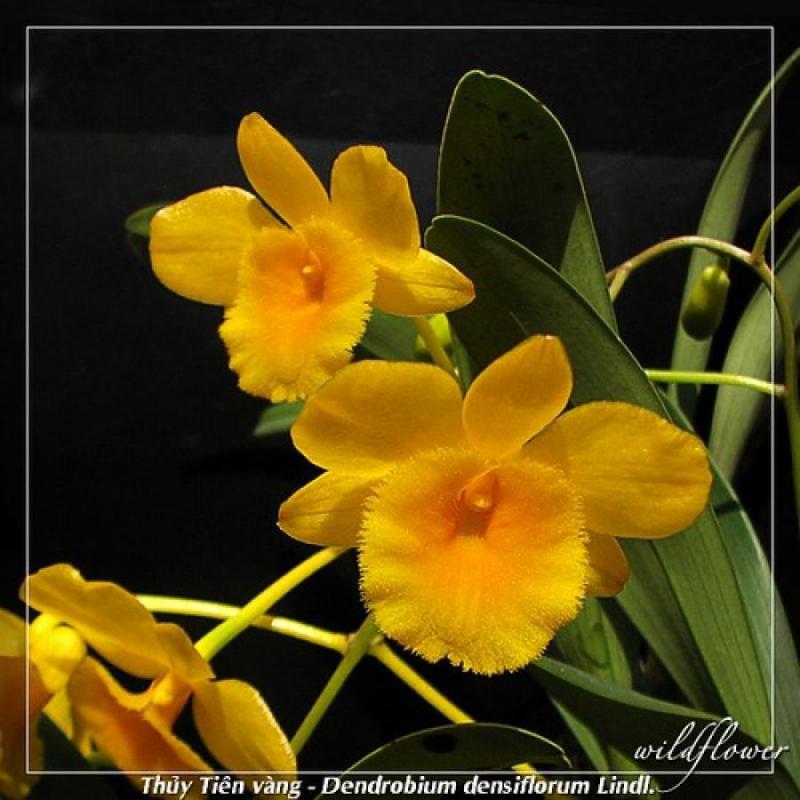Dendrobium densiflorum
Also known as: The Densely Flowered Dendrobium or Dendrobium densiflorum h.v. griffithii Dendrobium densiflorum h.f. albo-luteum Dendrobium schroderi Dendrobium clavatum h.f. suavissimum Endeisa flava Dendrobium schroederi Epidendrum dumunsuttu Dendrobium densiflorum var. clavatum Dendrobium densiflorum f. parviflorum Callista densiflora Dendrobium clavatum in the subfamily: Epidendroideae
Native to: Bhutan China India Thailand
General Information
The Densely Flowered Dendrobium is a small to medium sized sympodial cool to warm growing epiphytic or lithophytic free-flowering orchid belonging to the sub family Epidendroideae native to Bhutan, China, India, and Thailand.
Plant Description
Sympodial. Grows to 30-45cm. Each new growth has numerous leaves that grow to 15cm long. Pseudobulbs grow to 30-45cm
Flowers
Numerous fragrant blossoms appear readily during Spring
Fragrance
The orchid is fragrant.
Blooming Season
- Spring
Substrate(s)
- Coarse
Care Notes
This orchid goes into a dormancy phase during winter, during this phase it is best not to provide water unless the plant is starting to look thirsty. The lack of water increases the chance of flowering in spring, and also reduces the likelihood of any rot forming. Do not resume watering until new growth has appeared and is growing strongly.
Often a period of intense growth occurs after dormancy. During this time the amount of light, water and fertiliser the plant receives will directly impact the amount of growth that occurs during this time, and in the case of seedlings, will reduce the time required to reach maturity.
It's recommended to heavily reduce the water amount at the middle to end of autumn to trigger dormancy. Leaves on older bulbs will begin to drop during this time while the newer bulbs continue to mature until terminal leaves appear at the tip of the pseudobulbs.
Repotting can be done any time of the year though it's best to do it in early spring when new growth is appearing as this also means new roots will appear to help the plant anchor into the new media and offset any damage to established roots during the repotting process.
Fragrant:
- IsFragrant
Climate
Grows at high elevations. Rainfall ranges from 5mm to 325mm per day, heaviest in August and lightest in December. Humidity ranges from 39% to 93%, highest in August and lowest in April. Temperature ranges from 9C to 31C, highest in May (22C to 31C) and lowest in January (9C to 17C).
Watering
These orchids prefer a constant supply of moisture, with a slight drying out between waterings. Saucers can be placed under pots to retain moisture during hot weather, however the saucers should be removed or let to dry every 1-2 weeks to prevent rot. Keep an eye on the plant especially in hot weather and look for cues of under/overwatering and adjust accordingly.
Keep moisture levels up during hot weather as the plant is prone to dehydrationFertiliser
These orchids do not need to be regularly fertilised and roots may be sensitive to salt build-up, dying back and therefore impairing the plants growth or even killing it.
If fertilising, use half to quarter of the recommended amount of fertiliser. If they receive fertiliser as part of a collection, be sure to flush out the pots regularly with fresh water and monitor the roots by checking how much resistance is given by the plant when nudged in its pot or mount. If the plant becomes wobbly or loose, repot in fresh mix or rinse the media/mount thoroughly and do not fertilise for at least 3 months.
Apply fertiliser regularly at half strength year round. This plant is sensitive so apply fertiliser sparingly at one quarter recommended strength or less. Use a high Nitrogen fertiliser during Summer. Use a high Phosphorous fertiliser during Summer.Potting
These plants are quite forgiving and will do well repotted ever 2-3 years. The mix should be coarse, well draining, and allow space for air to move and for roots to grow.
Alternatively, these plants will also do well mounted to tree fern or cork slabs, or mounted to trees.
Best time for repotting or mounting the orchids is the end of winter when new growths start to appear. Avoid repotting during hot weather,
This plant does well mounted to Cork slabs.




















